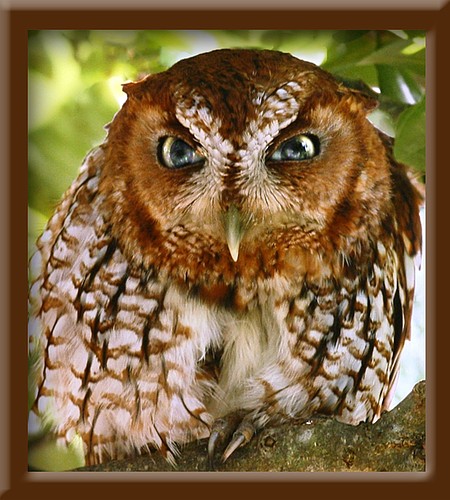- April 19, 2024
-
-
Loading

Loading

Otus Rufous, an Eastern Screech-owl, was born on Siesta Key and is a full-time resident there. An avid hunter, accomplished vocalist and genuine night owl, Otus is a keen observer of our local wildlife and knows many of nature's secrets. Otus will answer your questions about our amazing wildlife, but only if you Ask Otus™.
Dear readers,
Having carefully explained in a previous column how important the results of the Jan. 4th Sarasota Audubon Christmas Bird Count (CBC) on Siesta Key are to understanding the health and well-being of our key's birds and, by extension, its residents, I was expecting hundreds of letters from readers anxiously asking "Well, how did it go? Is it safe to eat that bay-caught Red drum I filleted and froze last week?" As it was, I received only one question. It was from a CBC team member: "Dear Otus, Did you find a gray suede fur-lined glove? I think I dropped it under your tree."
Yes! It was that cold on that dreary, gray, drizzly day. Many bird species common to our key refused to come out and play Hide-and-Seek with the CB C team. Nevertheless, 69 species of birds were found and "checked" off the list (last year's count was 77 species). The total of birds tallied was 1,444 (2,755 last year). And 1 out of 7 dwarves is Grumpy.
As I've written before, numbers and statistics are a dry, lifeless lot. So let me breathe some life into them and add a few feathers. I shall highlight several "checked" species and explain what these numbers should mean to readers.
Our key's 16 resident Osprey, particularly when found in their established or new nesting sites, confirm the health and well-being of the fish in our Gulf waters and Little Sarasota Bay. This is also true of the visiting Red-breasted Mergansers (255) and 23 American White Pelicans. Fisherfolk are now reassured they can consume their "catch-of-the-day" and fish are plentiful, well, unless the birds eat them all up.
The newbies not only spotted the 2 Belted Kingfishers at their dock, but actually knew what they were! They are evolving into seasoned CBC team members. The Belted Kingfisher, which dives into the water for small fish and crustaceans, leaves northern climes in winter when bays, lakes and estuaries ice-over. The Kingfishers' presence here proves our bay is not (yet) ready for skaters.
Many private property owners kindly allow the CBC team access to backyards and condo grounds where numerous migrant warblers, vireos and 50 (!) American Goldfinch were found flitting about, eating insects, berries, and seeds. They were not only seen but were also properly identified! This is not an easy task in dark gray lighting, when tiny birds are obscure blobs in the dark shadows of tree branches. In sunlight the flash of buttercup-yellow on a small Common Yellowthroat (1) not only reveals its location but helps in its identification. Why is the presence of these little birds important to Siesta Key? Because the preservation of our key's natural landscape is constantly under pressure from new construction, eradication of Florida-native plants, and the overuse of chemical pesticides. The continued appearance of migrant and resident passerines on Siesta suggests that more and more people are introducing elements of Florida's natural wilderness into their "formal" gardens. This attracts and helps maintain Mother Nature's natural pesticides — passerines and other insect-devouring species, especially bats and dragonflies (which are not birds!).
What does it mean to people on Siesta that some 230 Brown Pelicans and over 350 Ring-billed and Laughing Gulls were counted? It means that yard maintenance crews, boat and car owners will spend a lot of time scraping up poop from docks, tarps, kayaks, and walkways. He who laughs last?
Since the Audubon CBC's inception, 114 years ago, it has been the privilege of Eastern Screech-owls to preside over the ceremonial awards presentation in which First Prize for Best-in-Hiding and Booby Prize for Worst-in-Hiding are bestowed upon meritorious avian subjects. The reason my species was singled out has nothing to do with the fact we are wise, prescient, and charmingly photogenic. It is because we are nocturnal and most of the awarded subjects are diurnal. As we "night owls" nap during the day our awards ceremonies are mercifully brief. No interminable speeches or forced gratuitous humor. It's "Here's your prize. Now, nap!"
This year's Best-in-Hiding prize was awarded to Green Heron. Day in, day out, like clockwork, our little Green Heron perches on the bridge railing of Heron Lagoon. But he was simply nowhere to be found CBC day. Good no-show, little Green Heron!
Booby Prize for Worst-in-Hiding. Hmmmm ... That was shared by 6 Eastern Screech-owls (that's me!). You see, it was mating season and we just couldn't stop those melodically rapturous love songs bursting from our lovelorn hearts. Our calls led the team right to us. Oops!
In a newly introduced category, the Prize for Best Costume went to the CBC team. They were dressed for seeking penguins rather than Florida's rare Reddish-egret (1).
Sixty-nine species of birds were "checked" that day. Can you name 20 bird species? "Seagull", "little bird", and "duck" do not count! If not, perhaps this pop quiz will inspire you to learn their names and how to distinguish between similar-looking species. The photographs are of birds commonly seen around Sarasota, but some of them are a bit tricky so ... Good luck! You'll have the answers next week, providing I find my crib sheet.
Now, let us nap!
Otus